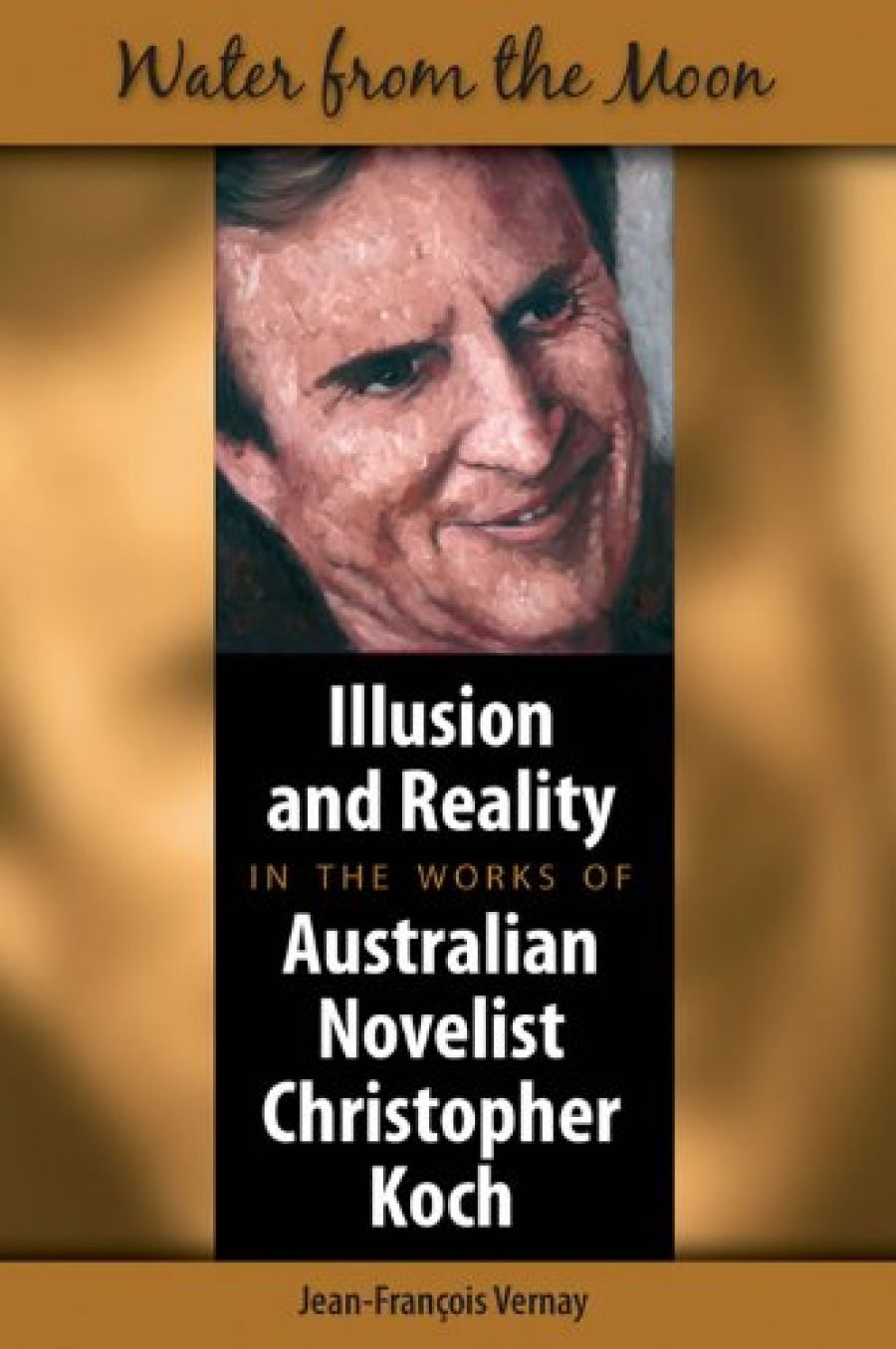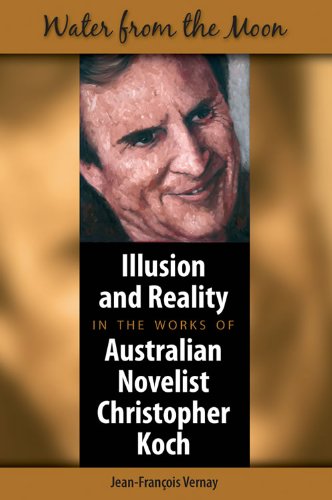
- Free Article: No
- Contents Category: Literary Studies
- Review Article: Yes
- Article Title: Blurry Portrait
- Online Only: No
- Custom Highlight Text:
Reading literary criticism can be like viewing a portrait: you are essentially subjected to another person’s vision of the subject. One can feel that the perspective is unduly harsh at some points, lavishly lenient at others. It is easy to project one’s own bias onto the work, and to take issue with the representation too quickly. This is particularly true of a critical monograph on a subject such as Christopher Koch, who has been both prominent and controversial throughout his career. It is difficult for any commentator on Koch not to be drawn into the ‘Australian Melodrama’ that Peter Pierce identified in Australian literary culture in 1995.
- Book 1 Title: Water From the Moon
- Book 1 Subtitle: Illusion and reality in the works of Australian novelist Christopher Koch
- Book 1 Biblio: Cambria Press, $84.95 hb, 207 pp
- Book 1 Cover Small (400 x 600):

- Book 1 Cover (800 x 1200):

In his review of Noel Henricksen’s Island and Otherland (2004), Vernay argued that Henricksen wrote a hagiography with undue focus on Koch’s life at the expense of literary readings. Vernay himself has generally avoided this trend, despite occasionally bombastic claims such as ‘[h]is love of poetic language and lyrical flights of fancy have endowed him with a matchless gift to stir the reader’s emotions’, and ‘Koch reveals people’s many-sided nature through this mesh of insightful characterisation’.
However, Vernay neglects to discuss at any length Koch’s most recent non-fiction, The Many-Coloured Land: A return to Ireland (2002). This is a serious omission, especially since The Many-Coloured Land is crucial to what Vernay identifies as Koch’s Weltanschauung. The palette used to portray Koch is thus incomplete: it lacks an essential ingredient.
Nonetheless, Water from the Moon has much to offer. It draws on substantial research and publication on Koch’s work: Vernay completed a PhD on Koch at the Université Toulouse-Le Mirail, in Nouméa. He is clearly familiar with Koch’s oeuvre. Chapter 2 offers an excellent close reading of Koch’s poetic stylistics in The Boys in the Island (1958): this is the kind of analysis that is lacking in Koch scholarship so far. Later, Vernay attempts to apply theoretical concepts and methodologies to Koch’s work, a difficult but important project that enjoys limited success.
One of Vernay’s areas of expertise is psychoanalytic theory, and his application of various French theorists yields some valuable insights. For example, the analysis of the characterisation of Francis Cullen in Koch’s first novel applies an appropriate definition of the term ‘schizophrenic’ to explore the dualities in the protagonist. This is very promising, but such analysis is not sustained properly and Vernay falls into the same trap he identified in Henricksen’s monograph: ‘the arguments generally lack cogency.’
This is partly due to the confused and uncertain structure of Vernay’s book. Chapter 1 provides a brief introduction to Koch’s life and work, and Chapters 2–7 deal with each of Koch’s works in a chronological order. Chronology seems to be the only rationale for this structure, because the discussion returns again and again to Vernay’s major concerns: psychoanalysis, post-colonialism, the autobiographical element in Koch’s work, and the relationship between history and fiction.
This structure vacillates between chronological and thematic ordering. Admittedly, Vernay warns the reader in his preface that ‘I have taken the liberty to discuss his books one after the other while keeping them all in mind’, but this does not prevent the reader from becoming deeply disoriented when the monograph returns again and again to the same themes and texts. The rationale is not clear, and the repetition becomes frustrating. The book may benefit from some fundamental restructuring along the thematic lines Vernay implies: a more thorough and consistent focus on the motifs of illusion and reality would help.
The greatest weakness of this structure is that the issues suggested by Vernay’s chapter subheadings do not receive full treatment, and the resulting picture of Koch’s work is patchy and inconsistent. The sections which deal with broadly post-colonial issues are promising: Vernay mentions Koch’s depiction of ‘multifaceted Asia’, ‘Koch’s whitewashed hybridity’, Australia’s attempts at cloning English society, and the Eurocentrism of some of Koch’s characters and contemporaries. Despite this potential, these issues are dealt with at various points throughout the whole book, and so the discussion lacks theoretical rigour. Vernay evokes the shadows of thinkers such as Edward Said, Homi Bhabha and Mary Louise Pratt without dealing with them explicitly, and the one quote (in French, untranslated) from Foucault is insufficient to support any theoretically informed argument. Vernay is clearly aware of the issues and debates involved, but there is too little supporting evidence to make his claims convincing.
This problem may be due to the lack of a clearly defined audience. Although Vernay’s veiled attack on Henricksen’s ‘commercial appeal’ suggests that he is aiming for a more informed and academic audience, his lack of explicit and thorough attention to theoretical debates undermines this intention. It seems that the author is hedging his bets.
This lack of rigour is apparent when Vernay discusses history and ‘faction’ in Koch’s work. His earlier discussion of fictional reality and historical realism does take appropriate account of influences such as Tolstoy and Dostoevsky on Koch’s work, but it neglects Koch’s basis in the adventure fictions of writers such as Joseph Conrad, Graham Greene, and W. Somerset Maugham. The approach is flippant. The claim that ‘[i]n this respect, both historians and novelists are myth-makers’ conflates the disciplines too easily and ignores fundamental differences in methodology.
This is perhaps the most serious weakness of the book. In discussing Australia’s contact history, Vernay’s casual deployment of the phrase ‘homicides, if not a quasi genocide’ betrays a deep lack of familiarity with the ‘history wars’ debate which has been so prominent in Australian intellectual life in recent years. Koch’s representations of Asia, his depictions of women and his fraught relationships with the academic community are also not properly dealt with. The discussions of faction and Tony Wren/Shane Noonan, and Michael Langford as not being a convincing Christ-figure are particularly unsatisfying. A reader familiar with these issues in Koch’s work might seek a more in-depth exploration of them, while a general reader may well be happy with having them simply raised for consideration.
Despite these flaws, this is an important book, and a valuable contribution to what Vernay correctly identifies as a neglected area in Australian literary studies. It may be a patchy and incomplete portrait, but it fills a wide gap in the gallery of Australian literary criticism. For this reason, it will appeal to avid readers of Koch as well as those not so familiar with his work. Water from the Moon is a testament to the richness of Koch’s work and to the difficulty in analysing, categorising or pigeonholing it. It is a fitting (but backhanded) tribute to an author who has always vocally opposed the appropriation of his work for political, social or ideological ends.


Comments powered by CComment